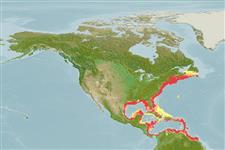Common names from other countries
Classification / Names / Names
Namen | Synonyme | Catalog of Fishes (gen., sp.) | ITIS | CoL | WoRMS
Environment: milieu / climate zone / depth range / distribution range
Ökologie
Benthopelagisch; tiefenbereich 0 - 400 m (Ref. 275). Tropical; 10°C - 14°C (Ref. 275), preferred 21°C (Ref. 107945); 50°N - 8°N, 98°W - 53°W (Ref. 275)
Western Atlantic.
Length at first maturity / Size / Gewicht / Alter
Maturity: Lm 15.0 range ? - ? cm Max length : 50.0 cm ML Männchen/unbestimmt; (Ref. 275); 40 cm ML (female)
Common mantle length: 10.0 to 20.0 cm (Ref. 275, 3722). This is a neritic species found on sandy bottoms and along the water column (Ref. 83938). On coastal surface, epipelagic (Ref. 110525). Spends winter at depths of 100 to 200 m (Ref. 843). Overwinter along the continental shelf in offshore canyons as far south as Cape Hatteras (Ref. 106883).
Life cycle and mating behavior
Geschlechtsreife | Fortpflanzung | Ablaichen | Eier | Fecundity | Larven
Members of the class Cephalopoda are gonochoric. Male and female adults usually die shortly after spawning and brooding, respectively. Mating behavior: Males perform various displays to attract potential females for copulation. During copulation, male grasp the female and inserts the hectocotylus into the female's mantle cavity where fertilization usually occurs. Life cycle: Embryos hatch into planktonic stage and live for some time before they grow larger and take up a benthic existence as adults.
Roper, C.F.E., M.J. Sweeney and C.E. Nauen. 1984. (Ref. 275)
IUCN Rote Liste Status (Ref. 130435)
CITES Status (Ref. 108899)
Not Evaluated
Not Evaluated
Nutzung durch Menschen
Fischereien: kommerziell
FAO - Fischereien: landings, Artbeschreibung | FishSource | Sea Around Us
Tools
Internet Quellen
Estimates based on models
Preferred temperature
(Ref.
115969): 5.9 - 26.3, mean 19.4 (based on 245 cells).
Widerstandsfähigkeit
hoch, Verdopplung der Population dauert weniger als 15 Monate. (K=0.59-0.95).
Verwundbarkeit
Low to moderate vulnerability (26 of 100).
